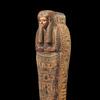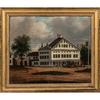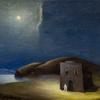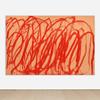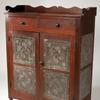An Unknown Jawlensky Portrait of an Intriguing Sitter Comes to Auction at Ketterer Kunst
- MUNICH, Germany
- /
- December 01, 2021
A work by the Russian Expressionist Alexej von Jawlensky that has been in private hands for the last century, and which has not been seen in public since the 1920’s, is being offered for sale by Ketterer Kunst, Germany’s premier auction house. Frauenkopf mit Blumen im Haar [Head of a woman with flowers in her hair] does not appear in the artist’s catalogue raisonné and was only presented to and validated by the Jawlensky archive in 2017. Painted around 1913, the portrait is of significant historical importance as it represents a turning point in Jawlensky’s practice as he moved away from the figurative paintings and landscapes which he previously considered his best works.
The work, which will be presented by Ketterer Kunst at its Evenings Sale in Munich on December 10, with an estimate of €2,500,000 — €3,500,000. Prior to the sale, the auction house will tour the painting around at its offices in Berlin, Dusseldorf and Hamburg, before finishing at its headquarters in Munich.
Says Dr. Roman Ziegelgänsberger, curator in the Department of Modern Art at Museum Wiesbaden, "The painting Frauenkopf mit Blumen im Haar is from the artist’s most important work phase shortly before the First World War." It was during this period that Jawlensky began to focus exclusively on the shape of the human head not as an individual but as a stylised, monumental being, using imagery which harked back to the Russian Iconography of his youth. The portrait titles also reflected this change from the individual to the universal, with titles like Französin [French Woman] and Frau aus Turkestan [Woman from Turkestan].
It is interesting to note that while Frauenkopf mit Blumen im Haar does not carry anyone’s name, as became typical of the way he worked, it does bear striking similarity to a painting by the artist, executed the year before. This work, entitled Lola, is widely believed to be a portrait of Lola Montez. Montez was one of the greatest adventuresses of the 19th century. Born in Ireland in 1821, her colourful life included critical success as a dancer in Paris, a potential affair with Alexander Dumas and becoming a mistress to King Ludwig I of Bavaria in 1846, who became a hugely controversial figure as a result of the connection. One of the reasons for his abdication in 1848 was his unpopularity following his decision to make her a naturalised Bavarian subject and countess. After his abdication, she fled to America.
In 1912, fifty-one years after her death, Joseph August Lux published a historical novel about her life which reignited interest in Lola Montez. Being part of the same artistic circles as Lux, Jawlensky would have been aware of this. “While it cannot be said with any certainty that Frauenkopf mit Blumen im Haar is a depiction of Lola Montez, there is a strong likelihood that it is in some way a representation of her. The similarities between the two works extends to the shape of her nose, the stylisation around her eyes and the fact that she is often depicted by artists wearing a flower in her hair,” says Nicola Countess Keglevich.
As Dr. Ziegelgänsberger explains, Frauenkopf mit Blumen im Haar is a particularly good example of Jawlensky’s evolving practice because ‘[a]lthough Jawlensky work [was] extremely powerful and expressive during this period, he also knew how to capture even the most subtle moods. This work is characterized by a kind of restrained melancholia that lies above it like a pleasant veil and which makes for its special charm. Not least because of this, the hitherto unknown painting with the hair painted in a blazing red and the billowing mint-cool collar can be considered a great discovery.’
Jawlensky was born in Russia and studied art under Ilya Repin. Having moved to Germany in 1896, he was a founding member of ‘Der Blaue Reiter’, a group of Russian and German artists, including Vassily Kandinsky and Franz Marc, which was fundamental to Expressionism. In 1937, 72 of his works were confiscated by the Nazis, and two displayed as part of their Die Ausstellung ‘Entartete Kunst’ [Degenerate Art Exhibition]. Nowadays, Jawlensky’s work can be found in art museums across the world.
Frauenkopf mit Blumen im Haar is being presented by Nicola Countess Keglevich in the Evening Sale at Ketterer Kunst in Munich, Germany, on 10 December 2021. This will be Countess Keglevich’s first auction for Ketterer Kunst after moving from Sotheby’s Munich branch. Says Keglevich, "We are very pleased that after such a long time we can now present this work of the highest museum quality for the first time on the art market… It is a great opportunity to finally have a chance to win a work from the artist’s most sought-after period, as comparable works are very rarely offered on the auction market."
Also appearing in this auction are Emil Nolde‘s famous Buchsbaumgarten [Boxwood Garden] (estimate €1,200,000-€1,800,000) entrusted to Ketterer Kunst by the Littmann family following the amicable resolution of the restitution case, as well as a triptych by Albert Oehlen (estimate: € 1,500,000-2,500,000) as part of the Post War selection.
Alexej von Jawlensky began his artistic training in 1889 in St. Petersburg after a career as an officer in the tsarist army. He studied under Ilya Repin who introduced him to Marianne von Werefkin and Helene Nesnakomoff, his later wife. Jawlensky accompanied these two to Munich in 1896 where they wanted to visit a private art school. Here Jawlensky met Wassily Kandinsky. The artist undertook several trips to France and was able to show ten paintings at the ‘Salon d’automne’ with the help of Sergei Diaghilev. Jawlensky also met Henri Matisse for the first time.
In summer 1908 he worked with Kandinsky, Marianne von Werefkin and Gabriele Münter in Murnau for the first time. There, the four artists developed the idea for the foundation of the ‘Neue Künstlervereinigung München’ to which they aligned with other artists. In December the first exhibition took place in Munich. Two years later the ‘Blauer Reiter’ was established as a new idea of co-operation. In 1913 Jawlensky participated in Herwarth Walden’s first German autumn Salon in Berlin. When in 1914 World War I began, Jawlensky was expelled from Germany due to his Russian citizenship. He moved with his family and Marianne von Werefkin to Prex on Lake Geneva and remained in Switzerland until 1921, where he began painting his abstract heads in 1918.
His final move to Wiesbaden took place in 1921. An attack of arthritis in 1929 forced the artist to visit various spas at regular intervals. Jawlensky suffered from a progressing paralysis and had difficulties in painting. One year later the painter began the series of small-format ‘Meditationen’. 72 of his works were confiscated in 1937 as “degenerate”. Three years later in 1941 Jawlensky died in Wiesbaden.
At the beginning Jawlensky’s style was influenced by the Fauves, particularly by Matisse, but the artist soon discovered his own, Expressionist style, which is characterised by strong colours and simple forms. Later he turned to those calm, spiritualised and mystical images of the human face, which are so typical of Jawlensky.
Contact:
Mark InglefieldAlbany Arts Communications
44 (0) 20 78 79 88 95
mark@albanyartscommunications.com
m.derra@kettererkunst.de
http://www.kettererkunst.com
About Ketterer Kunst
Ketterer Kunst was founded in 1954 and has headquarters in Munich, Germany, with branches in Hamburg, Duesseldorf, Berlin as well as a global network of representatives in, among others, the USA and Brazil. It is one of the leading houses for auctions of Fine Art from the 19th to the 21st Century and Rare Books. As market leader for art from the 19th to the 21st Century in the German language region, the expert for German art, according to the 2020 report issued by the artprice database, is the only and strongest-selling family business represented in the global Top 10.


_Infinity_by_Santiago_Medina_PhotoCr100x100_c.jpg)

